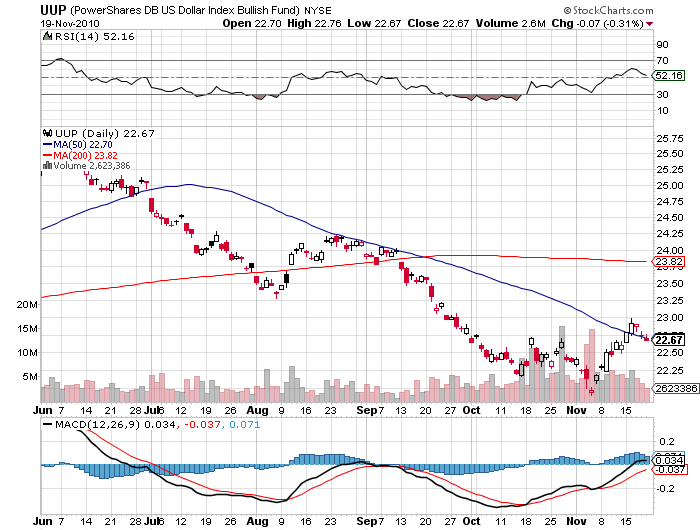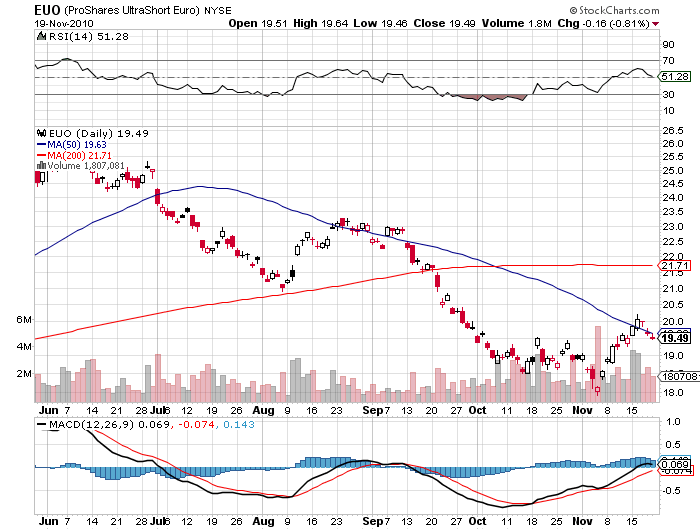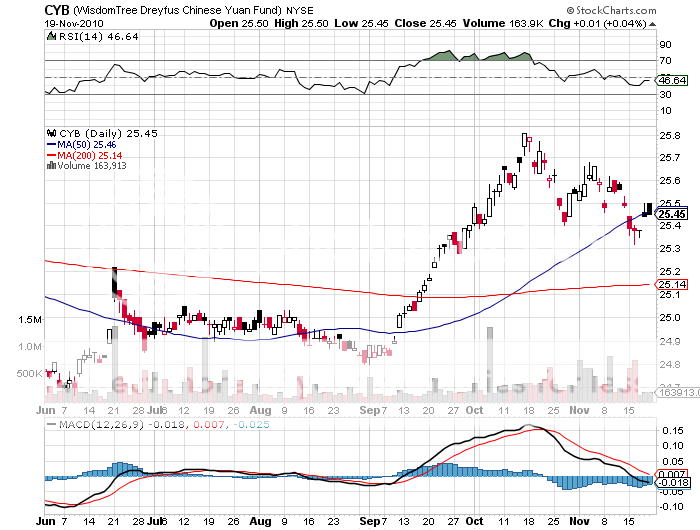
Featured Trades: (PORTLAND STRATEGY LUNCHEON)
1) The Portland Thanksgiving Strategy Luncheon. Many thanks to all who attended the First Annual Portland Thanksgiving Strategy Luncheon, whose repartee, give and take, and wide-ranging debate made the event well worth the trip from Fog City. I always take in more from these events than I dish out, which is why I do so many. Talking to local businessmen about conditions gives me a leading economic indicator to rival the Fed's, and there is always that hard core trader who has picked up a third derivative angle with an options play that I have somehow missed. Kudos to Paul, who won the prize for the greatest distance traveled, 385 miles from Coeur d'Alene, Idaho. Please spend your newly acquired Zimbabwean dollars freely.
Of course, I nearly froze wearing my summer suit to the soggy Pacific Northwest. It was so cold I received a free upgrade on my car rental to a fire engine red Dodge Charger, as the car wash was frozen solid, so only dirty cars were available. I feel sorry for the drunk who was tossed out of a downtown Portland bar, only to be found frozen to death in the adjacent ally the next morning.
An attempt by a Somali terrorist to explode a car bomb at Frontier Square during the Christmas tree lighting that night was an unwelcome development, even if it was a dud, provided courtesy of the FBI. This is the second time I experienced a near miss this year. My May New York Strategy Luncheon found a real car bomb parked in front of my hotel on Times Square, which was fortunately diffused in time. Was it something I said?
See you all next year, when hopefully, I shall have to rent the Grand Ballroom to accommodate all the guests. I urge Southern California residents to sign up for the next Los Angeles Strategy Luncheon this Friday,? December 3, where I expect a large contingent of 'snow geese' flying down from Alaska.

-
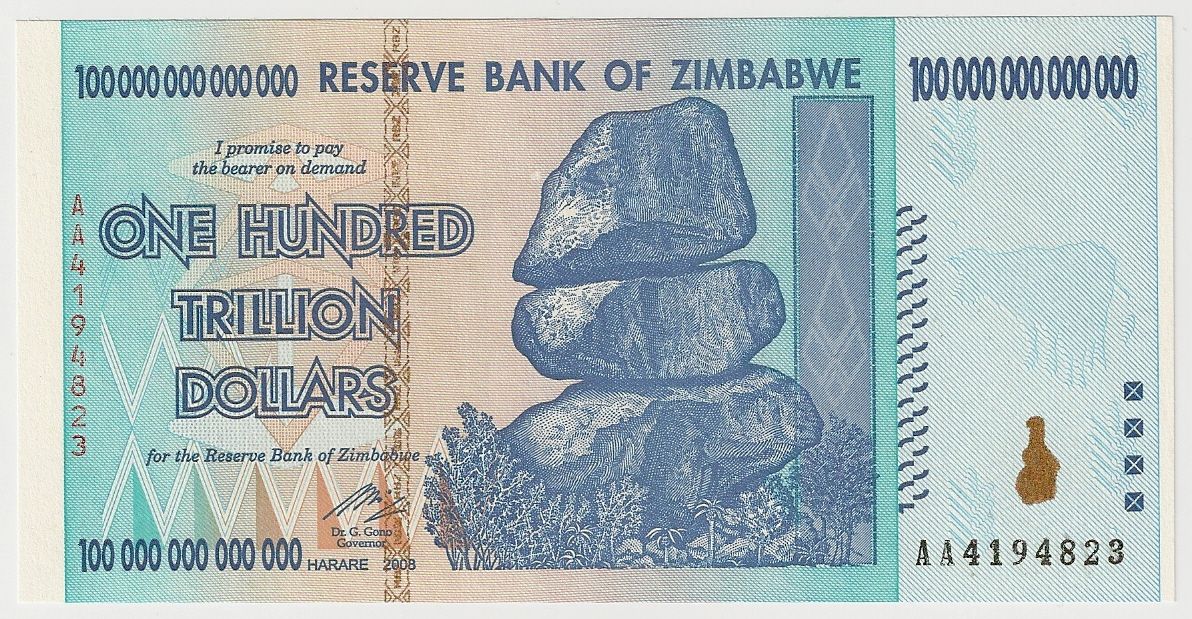
-

My Portland Strategy Luncheon Crasher
Featured Trades: (CHEVY VOLT REVIEW), (NSANY), (GM)
2) My Anti Review of the Chevy Volt. In 2011, we will we be deluged by an onslaught of advertising praising the virtues of the electric car, as models like the Nissan Leaf (NSANY) and the Chevy Volt (GM) hit the market. If last week's San Francisco Auto Show at the downtown Moscone Center was any guide, the faceoff between the two vehicles is all over but the crying.
After spending three hours test driving the Leaf and grilling Nissan's engineers on specs (click here for my piece), I strolled over to the General Motors display on the other site of the hall. There I found the Volt up on a pedestal guarded by two silicone enhanced hotties, who, while attractive, where clueless about the capabilities of the car. Perhaps they were strategically placed there to distract viewers from the design lines of the Volt, which I found utterly uninspiring. It's as if the car was designed by a committee of old ladies. The new Corvette Stingray, now that was inspiring.
When I asked them to open the hood, I was told it was disabled to prevent access to the public. The engine has been cleverly renamed the generator, even though it is still an engine. The car can drive 40 miles on an electric charge, when a 1.4 liter, 89 horsepower gas engine takes over, taking it a total of 350 miles. I'm told that 'range anxiety' was a big factor in GM's planning, which they learned the hard way from their painful and costly EV-1 disaster in the nineties. That project was killed off when oil plunged to $8 a barrel, and the world wanted to own Suburbans.
The 435 pound lithium ion battery is two thirds the weight of the Leaf's, with half the output, recharges from 240 volts in half the Leaf's eight hours, and carries the same eight year warranty. Could they start the engine up so I could check the noise level? No, the fumes would fill the hall in minutes, which was ironic, since I had just come from tearing up the grand ballroom in the exhaust free Leaf.
You get all of this for a non subsidized price of $42,000, some $10,000 more than the vastly superior Leaf. GM is doing a token launch along with the Leaf in December, but the vehicle won't be available in real numbers until early 2012. That's when Toyota brings out its plug-in Prius, with twice the performance with a flawless ten year track record for a third less money. By then, Nissan will own the market. Talk about a day late and a dollar short. Haven't we seen this movie before?
If you were wondering why I was boycotting the GM IPO, this was a big reason. Despite all of the promises by an earnest new management, GM is still pumping out lemons. I have a feeling that the big buyer of this car will be the US government, as it is still a major shareholder in the company. For decades after the 1979 Chrysler bail out, my government ride was always in one of their vehicles. You'd be better off buying another Suburban.
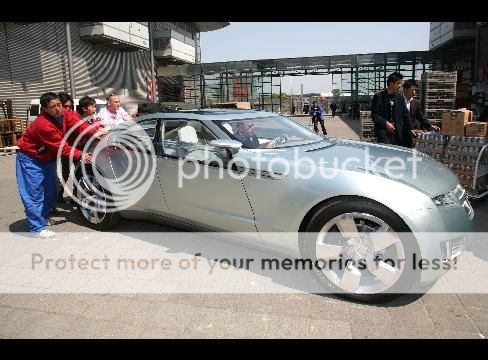
Ready to Buy From Government Motors?
Featured Trades: (JAPANESE YEN), (FXY), (YCS)
3) Your Engraved Invitation to Sell the Yen. It is looking like the worm has finally turned on the Japanese currency. After tickling ?80.20 for a nanosecond on November 1, it has swan dived. It didn't even rally during Thanksgiving week, when Uncle Buck momentarily sold off against most currencies. We broke the 50 day moving average at ?82.60 on November 15. The November 30 close promises to deliver a 'monthly outside reversal', which is a big deal for technical analysts.
Of course, I have been banging the table for some time, insisting that the yen was the world's most overvalued asset (click here for 'The Collapse of the Yen: The Party Has Started' and click here for 'Pricking the Bubble in the Yen'). The economic rationale is really quite simple. The US economy is enjoying a growth spurt, possibly to a 3.5% annualized rate, while the Land of the Rising Sun is as dead as a doorknob. This has triggered rising American interest rates, especially at the long end, and an opened up a widening interest rate differential in favor of the greenback. This forces international capital to migrate irresistibly out of the yen and into the dollar.
The Japanese currency is printing ?84 as I write this. I think worst case, the yen continues to chop around in a ?80- ?85 range. Best case, it just keeps falling. Remember to think in inverse terms with the yen, which means that a trip from ?80 to ?85 is a move down. If you don't get something on board soon, you end up reading about this in the Wall Street Journal, instead of counting profits in your trading account.
Keep in mind that this not a riskless trade. If Congress gridlocks, and there is no extension of the Bush tax cuts for anyone, the double dip recession plops right back on the table, and it will be off to the races for the yen once again. So a short on the yen here is essentially a bet that our august leaders won't commit collective political and economic suicide, which is no sure thing.
The easiest way into this trade for retail accounts is to buy the 200% leverage short ETF (YCS), which is now trading at $16.85. Since it has already run up 13% in four weeks, only take a 1/3 position here, invest another 1/3 on any pull back, and the last 1/3 on continued strength. The initial medium target should be the 200 day moving average at $18.67, and I bet this baby makes it to $40 someday. And keep a stop loss in at $15 in case an atomic bomb explodes in Washington.
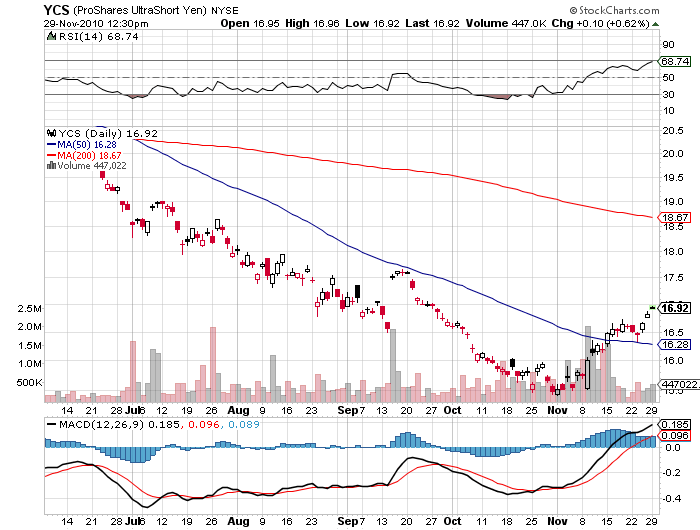
-

The Yen is Not as Strong as it Looks
'People are starting to feel better here. They don't feel like they have to have Dr. Kevorkian on speed dial anymore,' said Scott Nation, president of Nation Shares.

'The really big problem here is that we have 10% unemployment now. If you drop it 1/2% a year for ten years, we're not going to reach full employment before we reach the next recession,' said Lachmann Achutman, managing director of the Economic Cycle Research Institute

Featured Trades: (SAN FRANCISCO HARD ASSET CONFERENCE),
(GOLD), (SILVER), (PLATINUM), (PALLADIUM),
(GLD), (SLV), (PPLT), (PALL)
1) The San Francisco Hard Asset Conference. Attending the San Francisco Hard Asset Investment Conference this week, I learned that the people who inhabit this world are different from you and I. They camp in remote, mosquito infested swamps, risking hepatitis or dysentery, or 100 degree below zero temperature in the frozen wastelands of the north. The mines in which they toil present dangerous and claustrophobic working conditions in unbearably hot deserts and stifling jungles. They do this in the world's most corrupt countries where they will happily expropriate your holdings and throw you in fetid, stinking jails if the required 'consulting fees' go unpaid.
They do all of this so when you shake their hardened, calloused hands with red dirt under their fingernails and you look into their darkly tanned faces they can tell you with the fervence of a religious zealot that the value of their metal, ore, mines, exploration rights, or stock price are about to take off like a rocket. Perhaps it was appropriate that gold hit a new all time high this month, which explained why so many of the visitors seemed to be floating by on a cushion of air. Everyone seemed to be wearing better tailored, suits, cleaner shirts, and sharper haircuts than last year.? These were the hard core faithful who suffered a 20-year bear market in hard assets, and even hung on during the dark days when gold plumbed the depths to $260/ounce in 1999, and were now witnessing the second coming.
The conference was one of the most satisfying I attended this year. I spent half the time, going from table to table, thanking them for delivering the stellar performance I promised would arrive, companies like Avalon Rare Metals. I spent the other half signing programs for enthralled visitors who spotted my conspicuous Mad Hedge Fund Trader nametag.
The gold and silver coin dealers were there in force with their usual patter and free lotteries. There were a number of new Canadian mining companies raising money for an IPO or a secondary on the back of their latest findings in the field. The uranium and yellow cake producers were waxing eloquent about the nuclear power boom in China and the coming renaissance in the US (click here for my piece).
The poster child for the conference had to be the rare earths miners whose stocks have clocked meteoric 400% returns in the past six months. What I heard from the other attendees was fascinating. At least 30 others told me they sold all their real estate in 2004-2005 and poured the proceeds into hard assets, which have since doubled, tripled, or quadrupled.? I received no end of tips about better than expected assay result from exploratory core drillings in British Columbia, Chile, and Gambia. I steered clear of the booths staffed by hotties who clearly had more firsthand knowledge of silicon, than gold, silver, copper, or uranium.
While the long term fundamental case for gold, silver, and other hard assets is overwhelmingly positive, there is no doubt that it is overheated for the short term, and the recent $90 sell off over the last 10 days has shown. Still it is absolutely something to keep on your radar.
All in all, it gave a great overview on many key commodities and precious metals that are in long term bull markets. There are few sure things in life, but one for me is that I will be attending the next Hard Asset Investment Conference in New York during May 9-10, 2011 (click here for the link), which is free for all comers.
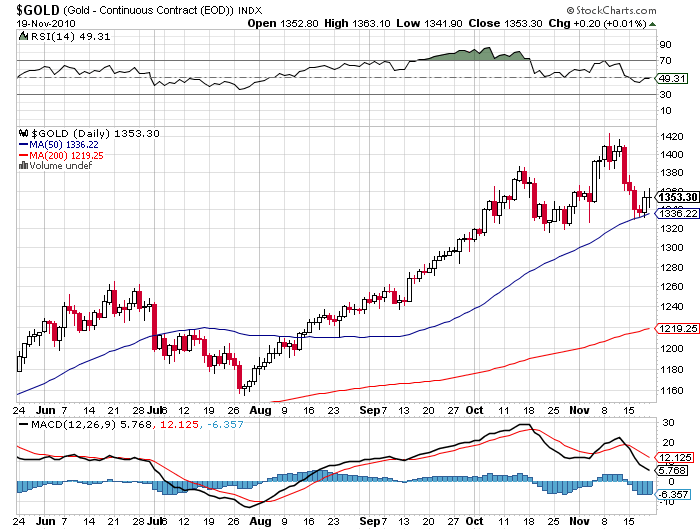
-

-
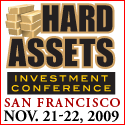
-

What a Chart is Supposed to Look Like
Featured Trades: (NISSAN LEAF), (NSANY), (F)
2) Taking a Nissan Leaf Out for a Spin. After five years of waiting, I finally got to drive the dream car of the future, the 2011 all-electric Nissan Leaf at the San Francisco auto show. Pulling a few strings with CEO Carlos Ghosn landed me a VIP test drive. It was one of the most surreal driving experiences that I have ever enjoyed, a lot like going on a new ride at Disneyland on opening day.
In the ultimate bit of cheek, Nissan set up a driving course defined by orange cones inside a 43,000 square foot ball room. Five cars zipped around the track like large remote controlled toys. The point was to show you that yes, this emission free vehicle can operate safely indoors. There is no tail pipe.
This is not a souped up golf cart. After comfortably sliding my 6'4' frame behind the wheel, I asked the rep to pack the car so I could give it a real test. Three farm boys from Tennessee, real heifers, dutifully piled in. It made no difference; The car took off like a Porsche.
The Leaf has a 100 mile range, can be recharged at home in eight hours, or at a public parking lot in 30 minutes. A GPS system constantly displays your remaining? range on a real time map, as well as the locations of the nearest charging stations. If you run out of juice on the freeway, Nissan offers free roadside service with an immediate recharge. With a 600 pound lithium ion battery lining the bottom of the chassis, it has tremendous stability, and corners like it is on rails. The battery comes with an eight year warranty and a ten year life.
My local utility was there cheering from the sidelines. PG&E is offering a special Plug-in-Vehicle rate of only 3 cent per kilowatt hour rate from 12:00 am to 7:00 am, compared to the standard top tier rate of 40 cents per hour, a 92% discount. That means the leaf's 100 mile drip will cost me 72 cents. This is the same as buying all the gasoline I want at 15 cents per gallon! In other words, the fuel is basically free.
When I asked the chief engineer about maintenance costs, I got a blank stare. Then he answered in a deadpan fashion, 'there is no maintenance'. During the first 100,000, the only expenses will be for brake pads and tires, as the 107 horsepower electric induction engine only has five moving parts.
You can get all of this for $33,000, which after a federal subsidy of $7,500 and a California state subsidy of $5,000, nets out to $20,500. Giveaway price, free fuel, free maintenance. Hmmmmm.
The car will only be sold initially in eight states, and I will be one of the first to get one in California. The entire US production run of 25,000, or 50,000 globally, has been sold out for next year, so you will have to wait until 2012 to get one. Nissan plans to ramp production in Tennessee up to 250,000 by the end of 2012, or 500,000 globally. Carlos Ghosn thinks electric cars will account for 10% of the global car market by 2020, or some 5 million units.
There are broader implications for the stock market with all of this. When Nissan Motors (NSANY), General Motors (GM), and others launch their advertising campaigns next year, I think there will be a media frenzy. Take a look at the share price of Ford Motors, and you know the industry has the wind in its sales, and an electric car boom could build it to hurricane force.
Think about what will happen next. What will these cars cost when the price of oil doubles, which I expect in the next five years? They should go through the roof. The production ramp up will, at the same time, cause economies of scale to kick in and costs to plummet. So Nissan will be working the income statement from both sides. That is what Ghosn is betting the company on.
Bottom line: For your longer term portfolios, buy Nissan shares on dips, and cash in on the hype.
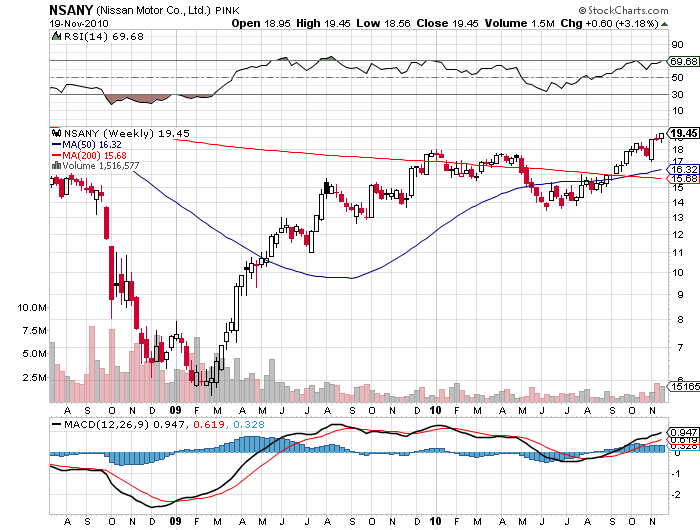
-
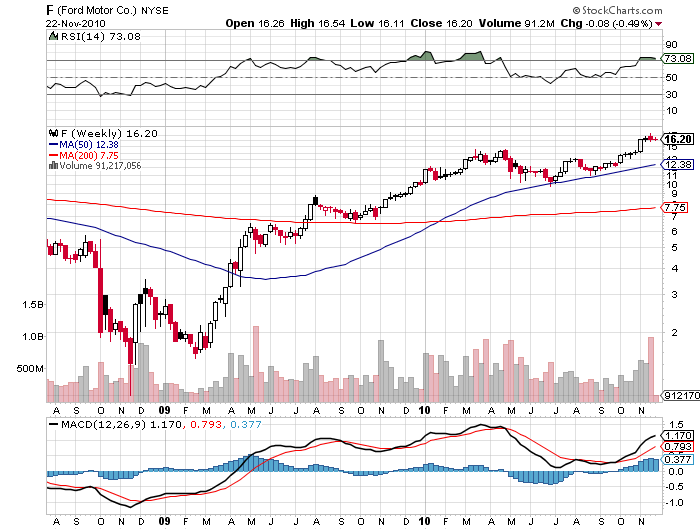
-

Sign Up For Your Free Transportation
Featured Trades: (ASSET ALLOCATION)
3) What About Asset Allocation? Asset allocation is the one question that I get every day which I absolutely cannot answer. The reason is simple: no two investors are alike. The answer varies whether you are young or old, have $1,000 in the bank or $10 million, are a sophisticated investor or an average Joe, in the top or the bottom tax bracket, and so on. This is something you should ask your financial advisor, if you haven't fired him already, which you probably should.
Having said all that, there is one old hard and fast rule which you should probably dump. It used to be prudent to own your age in bonds. So if you were 70, you should have had 70% of your assets in fixed income instruments and 30% in equities.
Given the extreme over valuation of all bonds today, I would completely ignore this rule and own none. That leaves cash, precious metals, commodities, and equities in which to concentrate your portfolio, and right now, cash is looking pretty good.

Allocation: Are You Him?

Or Him?
'The banks are effectively zombie banks, because their consumer and commercial assets are not growing and their fee businesses are getting crushed. You're looking at very low return vehicles,' said Meredith Whitney, CEO of the Meredith Whitney Advisory Group.


Featured Trades: (VIVIAN LEWIS ON HEDGE FUND RADIO), (PT), (EWZ), (TF), (UUP), (EUO), (PLND), (ECH), (PIN), (FXI), (GIFD), (PCY), (CYB)
1) Vivian Lewis of Global-Investing on Hedge Fund Radio. I managed to catch up with Vivian Lewis, the globetrotting publisher of http://www.global-investing.com/ , one of the oldest international investment newsletters in the industry. She was kind enough to grant me 40 minutes for a wide ranging interview for Hedge Fund Radio which left no corner of the globe untouched. The Renaissance woman reads no less than six languages, English, French German Russian, Dutch, and Portuguese, which she successfully puts to use finding out of the way foreign stock picks.
Vivian is bullish on the US dollar, despite the vast majority of traders happily positioning for the decline and fall of Uncle Buck. It's simply a matter of betting on the simultaneous strengthening of the US economy and a slowdown in Europe. Diverging tax and monetary policies on the continent are preventing them from getting their act together. The 'PIIGS' sovereign debt crisis is throwing the fat on the fire. The ETF (UUP) is her preferred vehicle here, which is long the dollar against a basket of currencies. My pick is the double leveraged version against the Euro, the (EUO) ETF. Vivian thinks that a strong dollar could lead to a broader flight from risk globally.
A scan of a Portuguese language news service enabled her to stumble across one winner, Portugal Telecom (PT), which is tying up with Brazil's privately held Oi to give it a share in the fastest growing telecommunications market in Latin America. This is no mean feat, as Portugal has been tarred with the 'PIIGS' brush, and is not exactly attracting a lot of risk capital these days.
She is being cautious on her sector picks in Brazil (EWZ) because a rapidly appreciating currency, the Real, is eroding their export competitiveness. Meat packers and breweries are good examples of no-go areas. Utilities are attractive because they sell purely into the domestic market. The Brazilian government is attempting to stem the Real's ascent by slapping a 10% tax on inward foreign investment, so far to no avail.
Vivian is coming off of a fabulous year, having moved her readers into the hottest emerging markets earlier than most. For her, it was simply a cherry picking exercise. She zeroed in on Thailand (TF) because it had good quality companies paying high dividends that had been beaten to hell by political instability and riots. Did I mention that they burned down the stock exchange??? A few family connections gave her the insight that the troubles would fizzle out, which they did.
Poland's (PLND) privatization program caused the country to pop up on her radar because similar policies adopted by Margaret Thatcher in Britain during the eighties proved immensely profitable for investors. Governments always sell stock cheap in these circumstances. Chile (ECH), the world's largest copper producer, was a 'BUY' after the earthquake failed to topple its stock market. India (PIN), which is playing catch up with China (FXI), also delivered stellar returns. Vivian even made money in Greece, the instigator of the 'PIIGS' crisis, by trading in high yielding preferred stock in the National Bank of Greece.
Vivian thinks long positions in the Yuan, the Chinese currency, should eventually turn profitable. But the Chinese government is in no rush to enrich hedge funds, so there is no way of telling when this will pay off.
Vivian has uncovered a small emerging markets fund trading at an 18% discount to net asset value, the Global Income Fund (GIFD). The (PCY), which also invests in emerging market debt, certainly gave me some juice in my own portfolio this year. Third Canadian General Income Trust, a Canadian fund of funds trading in Toronto (THD.TO) is similarly trading at a 35% discount to NAV.
Vivian graduated magna cum laude from Harvard in 1962, and took off for Europe, where she landed a job as the Paris correspondent of the prestigious weekly business magazine, The Economist. Vivian was one of the few token Americans there at this pillar of the British establishment, while I was the other one, working as the Tokyo correspondent.
After 18 years, she returned to New York and started Global Investing, a daily print newsletter then dedicated to American Depository Receipts, known as ADR's, Yankee bonds, and foreign preferred stocks. With the advent of the Internet, she moved online, built a global network of correspondents, and expanded her coverage to include new instruments like exchange traded funds.
To learn more about Global Investing, please visit her website at www.Global-Investing.com. To listen to my interview with Vivian on Hedge Fund Radio at length, please click here.
